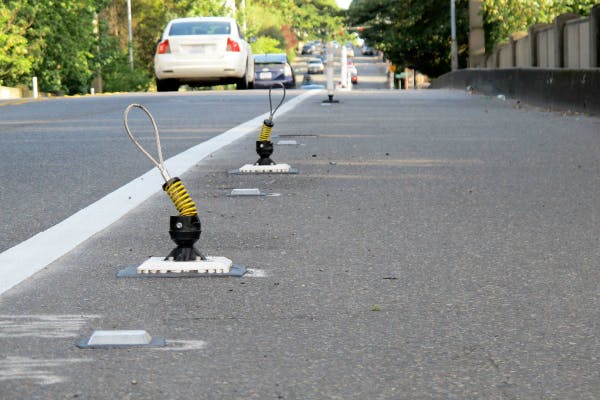Explore Our Network of Sites
Search
By:
As American cities have looked for simple, cheap ways to get physical barriers between bikes and cars, they’ve been reminded of a sad truth: you get what you pay for.
Cheap and fast solutions like plastic posts can be good, of course — especially in the world of protected bike lanes, where the role of such barriers isn’t actually to control a careening car but to give everyone on the street the subjective, accurate and reassuring sensation that bikes and cars are in fully separate spaces.
But there’s still a problem: once in a while, a motor vehicle will encroach on a post-protected bike lane enough to knock the posts down or tear them out.
Then there’s the problem of street sweepers, which come in surprisingly small sizes but are sometimes inefficient to use with post-protected lanes.
Seattle, the U.S. city that’s currently making the fastest progress in protecting bike lanes, has found a simple solution: posts that fold neatly down.
Tuff Posts are a product of Impact Recovery Systems.
Unlike the lower-cost candlesticks that have been embraced by various cities, Seattle has invested a bit more up front — $45 apiece for hardware, compared to $30 — because the more flexible version is designed to take up to 50 impacts at 55 mph from any direction.
The Tuff-brand posts even fold down neatly when a street sweeper passes over them, Seattle City Engineer Dongho Chang said.
For snow, the posts aren’t so great. Chang said there are posts available for that situation that can be unscrewed in advance of a plowing action, but the base installation for those is “a little more complicated.”
Chang and his colleagues now use the Tuff Posts for many protected bike lane projects as well as for low-cost road-level curb extensions that improve walking in the city.
“It pays for itself after the first hit,” Chang said.
Update: Bicycle Quarterly’s Jan Heine, a Seattle resident and a skeptic of low-cost protected bike lane treatments like these, has a useful counterpoint. He notes that once these posts are destroyed, it creates a pretty ugly hazard:

“I’d say in every other installation, at least one bollard is gone, spring exposed,” Heine said in an email. “As far as bollards go, maybe 1 in 10? And as they ‘age,’ it’ll be more common.”
That level of destruction isn’t anywhere close to what I personally observed around Seattle last month, but Heine spends much more time there and doubtless knows the situation better than I do.